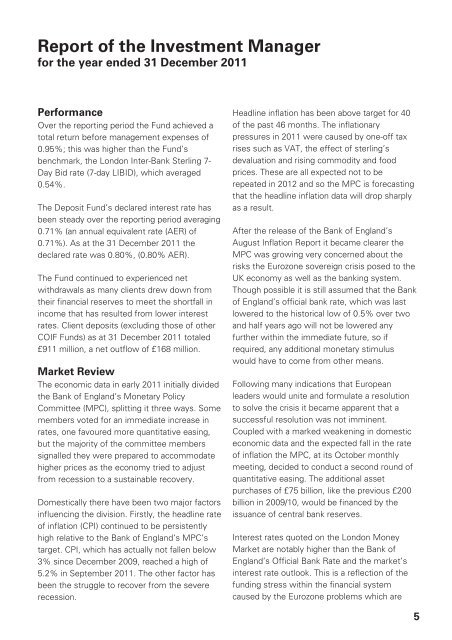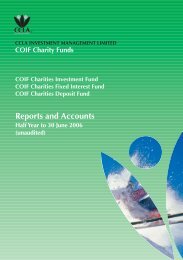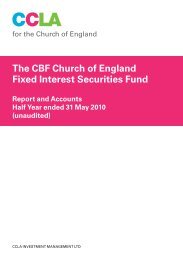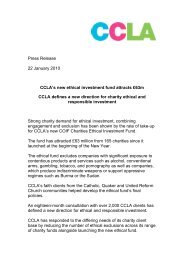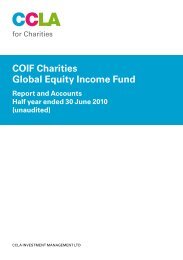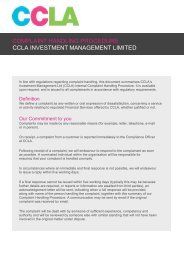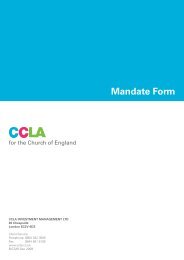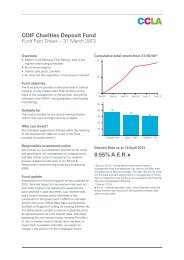Create successful ePaper yourself
Turn your PDF publications into a flip-book with our unique Google optimized e-Paper software.
Report of the Investment Managerfor the year ended 31 December 2011PerformanceOver the reporting period the <strong>Fund</strong> achieved atotal return before management expenses of0.95%; this was higher than the <strong>Fund</strong>’sbenchmark, the London Inter-Bank Sterling 7-Day Bid rate (7-day LIBID), which averaged0.54%.The <strong>Deposit</strong> <strong>Fund</strong>’s declared interest rate hasbeen steady over the reporting period averaging0.71% (an annual equivalent rate (AER) of0.71%). As at the 31 December 2011 thedeclared rate was 0.80%, (0.80% AER).The <strong>Fund</strong> continued to experienced netwithdrawals as many clients drew down fromtheir financial reserves to meet the shortfall inincome that has resulted from lower interestrates. Client deposits (excluding those of other<strong>COIF</strong> <strong>Fund</strong>s) as at 31 December 2011 totaled£911 million, a net outflow of £168 million.Market ReviewThe economic data in early 2011 initially dividedthe Bank of England’s Monetary PolicyCommittee (MPC), splitting it three ways. Somemembers voted for an immediate increase inrates, one favoured more quantitative easing,but the majority of the committee memberssignalled they were prepared to accommodatehigher prices as the economy tried to adjustfrom recession to a sustainable recovery.Domestically there have been two major factorsinfluencing the division. Firstly, the headline rateof inflation (CPI) continued to be persistentlyhigh relative to the Bank of England’s MPC’starget. CPI, which has actually not fallen below3% since December 2009, reached a high of5.2% in September 2011. The other factor hasbeen the struggle to recover from the severerecession.Headline inflation has been above target for 40of the past 46 months. The inflationarypressures in 2011 were caused by one-off taxrises such as VAT, the effect of sterling’sdevaluation and rising commodity and foodprices. These are all expected not to berepeated in 2012 and so the MPC is forecastingthat the headline inflation data will drop sharplyas a result.After the release of the Bank of England’sAugust Inflation Report it became clearer theMPC was growing very concerned about therisks the Eurozone sovereign crisis posed to theUK economy as well as the banking system.Though possible it is still assumed that the Bankof England’s official bank rate, which was lastlowered to the historical low of 0.5% over twoand half years ago will not be lowered anyfurther within the immediate future, so ifrequired, any additional monetary stimuluswould have to come from other means.Following many indications that Europeanleaders would unite and formulate a resolutionto solve the crisis it became apparent that asuccessful resolution was not imminent.Coupled with a marked weakening in domesticeconomic data and the expected fall in the rateof inflation the MPC, at its October monthlymeeting, decided to conduct a second round ofquantitative easing. The additional assetpurchases of £75 billion, like the previous £200billion in 2009/10, would be financed by theissuance of central bank reserves.Interest rates quoted on the London MoneyMarket are notably higher than the Bank ofEngland’s Official Bank Rate and the market’sinterest rate outlook. This is a reflection of thefunding stress within the financial systemcaused by the Eurozone problems which are5


